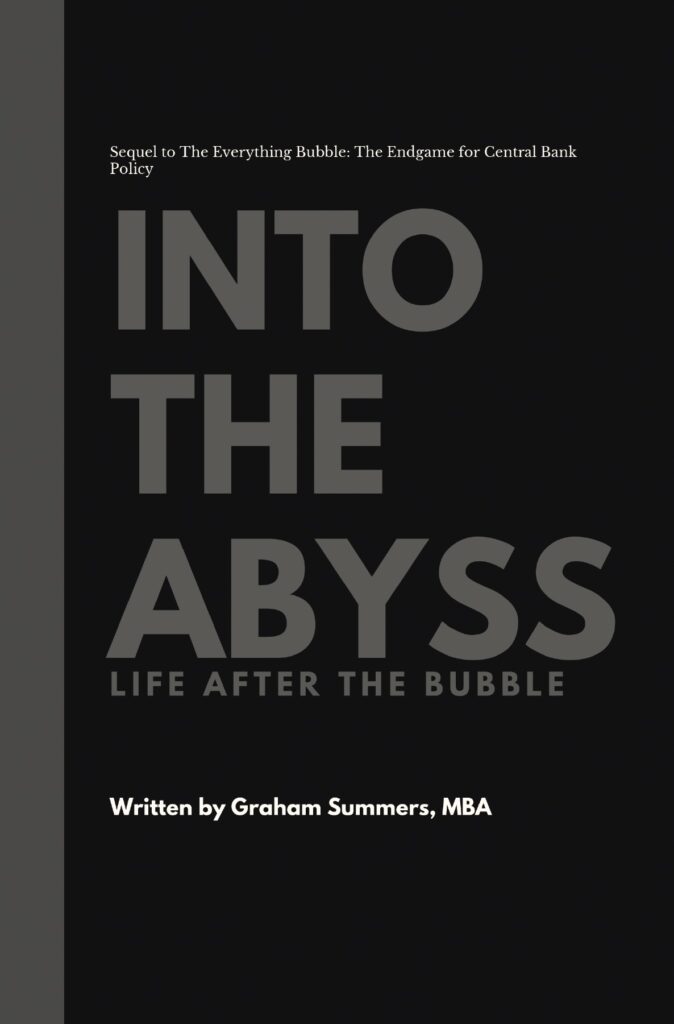THE ONLY REPORT INVESTORS NEED TO KNOW WHEN TO GET OUT OF STOCKS
LISTEN TO OUR PODCAST.
GRAHAM'S NEW BOOK WAS THE #1 NEW RELEASE IN FOUR CATEGORIES ON AMAZON
HOT TOPICS.
- 2008
- bail-ins
- bear market
- Bernanke
- big banks
- bond bubble
- bonds
- BOVESPA
- Carry Tax
- cash ban
- central banks
- China
- collapse
- contraction
- crash
- crisis
- debt
- debt crisis
- debt implosion
- deflation
- Derivatives
- economic collapse
- Federal Reserve
- inflation
- interest rates
- investing
- Jp MOrgan
- meltdown
- NIRP
- Operation Twist
- PboC
- Private wealth
- QE
- recession
- S&P 500
- slowdown
- stock market crash
- stocks
- TBTFs
- the Fed
- the market
- US Dollar
- War on cash
- Yellen
- ZIRP
Category Archives: Bank Crisis
The Fed is Forcing Americans To Pay MORE on Their Debts… For POLITICAL Reasons
Ready to get really furious? There is ample evidence that the current Fed, led by Fed Chair Jerome Powell, is highly political, making policy decisions based on political preferences rather than economic data, or what’s best for Americans’ pocketbooks. Case … Continue reading
Posted in Banana Republic Corruption, Bank Crisis, Central Bank Insanity
Comments Off on The Fed is Forcing Americans To Pay MORE on Their Debts… For POLITICAL Reasons
Is the Fed TRYING to Trigger a Debt Crisis?
By Graham Summers, MBA | Chief Market Strategist The Fed is in the political crosshairs. As I outlined previously, there is ample evidence that the Fed, particularly Fed Chair Jerome Powell acts in a highly political manner. This runs contrary … Continue reading
Posted in Banana Republic Corruption, Bank Crisis, Central Bank Insanity, stock collapse?
Comments Off on Is the Fed TRYING to Trigger a Debt Crisis?
Is the Stock Market About to Crash?
“Are the markets about to reverse course and crash?” This is the #1 question on investors’ minds today. The stock market has just staged one of its most spectacular “V-shaped” recoveries in history. And many investors are wondering if the … Continue reading
Posted in Bank Crisis, Central Bank Insanity, stock collapse?, The Markets
Comments Off on Is the Stock Market About to Crash?
Ok, This is Starting to Get Serious
By Graham Summers, MBA | Chief Market Strategist OK, now things are starting to get serious. As I’ve noted over the past week, while the Fed twiddles its thumbs and frets about the potentially inflationary impact of tariffs, the real economy is … Continue reading
Posted in Bank Crisis, Central Bank Insanity, Debt Bomb
Comments Off on Ok, This is Starting to Get Serious
Are You Ready For What’s Coming?
By Graham Summers, MBA | Chief Market Strategist As I write this, billions of dollars in capital are fleeing paper assets and moving into hard assets. See for yourself. Below is a chart of the price of gold plotted against … Continue reading
Posted in Bank Crisis, Central Bank Insanity, Inflation
Comments Off on Are You Ready For What’s Coming?
There is No Way Out of This That Doesn’t Involve Money Printing
By Graham Summers, MBA | Chief Market Strategist What is going on with gold?” This is the #1 question I’m being asked by clients. The answer is actually quite simple: gold recognizes that there is no situation in which the … Continue reading
Posted in Bank Crisis, Central Bank Insanity, Inflation
Comments Off on There is No Way Out of This That Doesn’t Involve Money Printing
What Happens if China Dumps Its Treasury Holdings?
By Graham Summers, MBA | Chief Market Strategist A very strange thing is happening in the markets. Historically, when the stock market collapses, money flees stocks and floods into U.S. Treasuries. The reason for this is that Treasuries are considered … Continue reading
Posted in Bank Crisis, Debt Bomb, stock collapse?, Trade Wars
Comments Off on What Happens if China Dumps Its Treasury Holdings?
Is This Major Country About to Default?
Japan is showing us the endgame for central bank insanity. Ever since the Great Financial Crisis, the Fed has been following Japan’s playbook for propping up a financial system. Indeed, everything the Fed has done, Japan originally nearly a decade … Continue reading
Posted in Bank Crisis, Central Bank Insanity, Inflation
Comments Off on Is This Major Country About to Default?
The Fed Has Created Another Bubble… Are You Prepared For When It Bursts?
By Graham Summers, MBA Everything changed for the financial system in March 2023. What happened then? The Fed and the Treasury implemented a backdoor bailout of the banking system. If you’ll recall, in late February/ early March 2023, a number … Continue reading
Posted in Bank Crisis, Central Bank Insanity
Comments Off on The Fed Has Created Another Bubble… Are You Prepared For When It Bursts?
How to Tell If Your Bank is in Trouble
By Graham Summers, MBA Dear Investor, You no doubt have some concerns about the bank at which you keep your deposits. I mean, why wouldn’t you? Three of the largest bank failures in U.S. history have already taken place this … Continue reading
Posted in Bank Crisis
Comments Off on How to Tell If Your Bank is in Trouble




